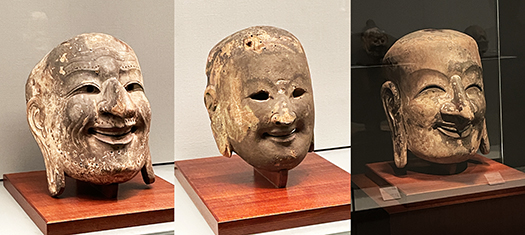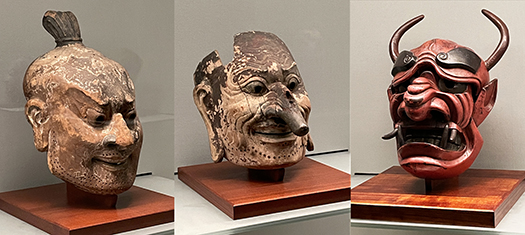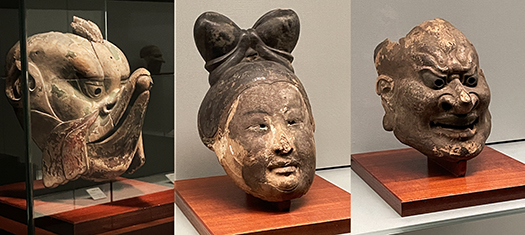


聖徳太子絵伝の探究の余韻のなかに依然としてあります(笑)。2005年から「毎日更新」をスタッフから申し渡されて18年間、毎日欠かさずに書き続けていますが、そうすると自分の「数寄」な領域にテーマがどうしても偏っていくようになる。まぁ自然な成り行きでしょうね。ライフワーク。
自分のフィールドとして住宅建築がメイン領域ですが、そこに収められるのは人間のくらし。住宅についての「価値判断」は結局、人間のくらしの好みのようなもの。そうすると類的存在としての人間を考えるのが主要領域化していく流れなのでしょう。歴史とは人間がいろいろな時間の中で「どう対応してきたのか」を教えてくれるもの。過去を知ることではじめて現在と未来を考えることができる。
そういう歴史というのは、いかにも人類らしく興味分野は多種多様に展開してくる。
基本は経済だけれど、精神文化が与える影響はすさまじい。そういう精神文化の典型として宗教がある。法隆寺宝物館展示で、最初期に仏教行事として大陸社会から導入されたというこの伎楽の面を一覧表示で見ていて、いかにも「芸能」のルーツを感じてならなかった。
聖徳太子の時代612年に朝鮮・百済から伝えられたことが伎楽の日本事始め。仏教という世界宗教を日本社会に導入して、東アジア東海の列島フロンティア国家として、世界の潮流にキャッチアップして独立国家圏・社会としての確立を目指すため、こうした宗教付随の文化も導入された。
日本ではこういう仏教導入のカタチだったので、中国南部地域由来とされる伎楽も、政権がその存立についてグリップするように成立してきた。Wikipedia記述では〜『延喜式』によると法隆寺をはじめ、大安寺、東大寺、西大寺などに伎楽を上演する一団がおかれていた。4月8日の仏生会、7月15日の伎楽会と、少なくとも年2回の上演があった。〜という記載。仏教寺院への大衆動員の「見世物」としての役割。
しかしそういう国家関与だったので、やがて関与が薄まるとともに形式は「現地化」していって、やがて獅子舞などの地域密着型芸能に変容していったのだとされる。先日のブログで韓国・ハフェマウルに残る仮面劇との類似性を書いたけれど、獅子舞のような変容のワンパターンと考えるとわかりやすい。
しかしわたし的には、これらの仮面に象徴化された人間の表情のピンナップぶりが刺激的。14種類の人間典型にそれぞれ独特の表情が固定化されているけれど、土俗的風俗的な典型化が人びとの笑いを誘ったとされる。そこには社会風刺・批判精神も見える化されている。
先人たちの思考がひとつひとつの仮面に託されて、人間世界の細部を語ってくれる・・・。
English version⬇
The “Gigaku” masks of the lion dance roots typify human emotions.
The unique facial expressions of the 14 types of human archetypes are formed, but there is also a social satire and critical spirit that can be seen. An opportunity for dialogue with predecessors. …
I have been writing every day for the past 18 years since 2005, when the staff requested me to “update this page every day,” and as a result, my themes have become biased toward my “sukkyoku” area. Well, I guess it’s a natural progression. Lifework.
My main field of work is residential architecture, but it is human life that is encompassed within that field. In the end, “value judgments” about housing are like preferences for human life. In this way, thinking about human beings as similar beings is becoming the main field of study. History is something that tells us “how humans have responded” in various times. Only by knowing the past can we think about the present and the future.
History, as is typical of humankind, has developed in a wide variety of fields of interest.
Although the basic focus is on economics, the influence of spiritual culture is tremendous. Religion is a typical example of such a spiritual culture. In the exhibition at the Gallery of Horyuji Treasures, I saw a list of Gigaku masks, which were introduced from continental society as a Buddhist event in the early days of Buddhism.
Gigaku was introduced to Japan from Baekje, Korea in 612 during the reign of Prince Shotoku, the first time it was performed in Japan. Buddhism, a world religion, was introduced to Japanese society in order to establish Japan as a frontier state in the East Asian archipelago, catching up with global trends and establishing itself as an independent national sphere and society.
According to Wikipedia, there were Gigaku groups at Horyu-ji Temple, Daian-ji Temple, Todai-ji Temple, Saidai-ji Temple, and other temples in Japan. According to the Engishiki, there was a Gigaku troupe that performed at Horyuji, Daianji, Todaiji, Saidaiji, and other temples, at least twice a year, on April 8 and July 15. 〜The first performance was held on April 8, and the second on July 15. The role of Gigaku was to serve as a “spectacle” to mobilize the masses to visit Buddhist temples.
However, because of the state’s involvement, the form eventually became “localized” as the involvement waned, and it is said that it eventually transformed into lion dances and other community-based performing arts. In a recent blog entry, I wrote about the similarity between the masked drama in Hafemaeul, Korea, and the lion dance, which can be easily understood as a pattern of transformation like the lion dance.
The pin-up nature of the human facial expressions symbolized by these masks is, to my mind, very stimulating. 14 types of human archetypes are fixed with their own unique facial expressions, but it is said that the earthly and folkloric archetypes drew laughter from the audience. The spirit of social satire and criticism is also visible in these works.
The thoughts of our predecessors are entrusted to each mask, and they tell us the details of the human world….
Posted on 6月 17th, 2023 by 三木 奎吾
Filed under: 日本社会・文化研究







コメントを投稿
「※誹謗中傷や、悪意のある書き込み、営利目的などのコメントを防ぐために、投稿された全てのコメントは一時的に保留されますのでご了承ください。」
You must be logged in to post a comment.